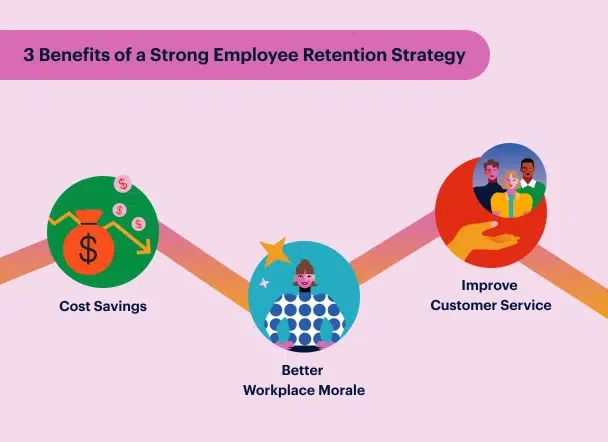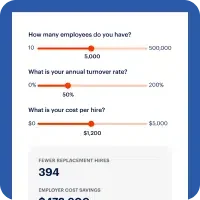Resource Center Reduce Turnover With an Employee Retention Strategy
Reduce Turnover With an Employee Retention Strategy

Companies across all industries can benefit from an employee retention strategy. By understanding the factors that are contributing to turnover, companies can develop a successful employee retention strategy that improves retention, employee morale, and revenue.
Simply put, employee retention is the percentage of employees who remain with an organization year to year. The percentage of employees leaving an organization determines the turnover rate.
On this page, we’ll discuss the various elements of an employee retention strategy, why it’s important to increase employee retention, and how a total reward package including on-demand pay contributes to strong retention.
What is an Employee Retention Strategy?
An employee retention strategy aims to increase a company’s year-over-year retention by providing methods to improve employee morale and, ideally, encourage employees to remain at the company. Methods to develop an employee retention strategy may include:
- Increasing employee incentives
- Improving financial security
- Defining clear career paths and growth opportunities
Organizations that don’t have an effective employee retention strategy may suffer from high turnover and the associated adverse effects that impact culture, revenue, and customer service.
Employee Retention by Industry
Typically, some industries have stronger employee retention rates than others. For example, government jobs come with pensions and clear retirement paths, which may contribute to a lower turnover rate.
Industries with the Lowest Employee Turnover Rate1
Percentage of employees by industry

On the flip side, the industries with some of the highest employee turnover in 2021 include:
Industries with the Highest Employee Turnover Rate2
Percentage of employees by industry

On-Demand Pay Improves Employee Retention Strategy
According to a report by DailyPay and Mercator, an added benefit such as on-demand pay may increase employee retention for organizations. On-demand pay has improved retention rates across the following industries:
+73%
for Nursing Homes
+68%
for Transportation
+51%
for Call Center
+27%
for Caregivers
+24%
for Retail
According to a DailyPay survey; 73% of employees have an improved opinion of their employer because of DailyPay.3 Additionally, 56% of users say DailyPay motivates them to pick up more shifts and 59% of users say DailyPay motivates them to go to work.4
Discover how on-demand pay may help bolster an employee retention strategy today.
The Negative Impact of Low Employee Retention
Low employee retention can negatively impact workplace culture and team bonding, reduce the overall company knowledge base, harm customer service, and rack up a variety of costs. These monetary costs may include:
- Departure costs: Time dedicated to determining the last pay, severance benefits, and securing equipment such as company computers or tools.
- Lost production: Gaps in production or project progress when experienced staff members leave. Customer service and sales can also suffer when employees who were knowledgeable and engaged with clients and prospects depart.
- Overtime costs: A loss in production may lead to overtime expenses as more experienced staff fill in gaps.
- Recruiting costs: This may include hiring a recruiting firm or advertising service to find a replacement, selecting interview candidates, conducting interviews, handling background checks, and testing.
- Onboarding and training costs: Processing new employee data, integrating data into payroll and benefits systems, and training new workers on tactical job requirements, company policy, and culture.
Find out how much your company can save by reducing your turnover rate with this interactive calculator.
Common Methods to Improve an Employee Retention Strategy
A comprehensive rewards and recognition program can improve employee retention strategies, reducing the employee turnover rate. This may also be referred to as a total rewards program and should include:
Compensation
Compensation not only involves how much an employee gets paid but how often. Employees dealing with financial stress will see negative effects on performance and productivity.
Benefits
A comprehensive benefits package that goes above and beyond competitors will give a hiring edge and contribute to employee appreciation and retention.
Employee well-being
Employees are looking to improve their work/life balance and reduce their stress levels. When employees are dealing with personal or financial stress, they may perform their job poorly with less efficiency.
Employee growth and development
Empowering employees financially sets them up for success and helps them develop healthy financial habits.
Rewards and recognition
Recognizing an employee for their hard work can play an important role in motivating and retaining employees.
The Benefits of a Strong Employee Retention Strategy
Cost savings
Employee turnover associated with poor employee retention results in various costs, as mentioned earlier. When a company retains employees, it can also expect cost savings by avoiding turnover-related expenses.
Better workplace morale
High turnover rates often impact employee morale. Unhappy and unmotivated employees are less productive and their companies are 21% less profitable than companies with higher engagement.5
Improved customer service
Companies with a strong retention strategy may see fewer interruptions in processes, leading to greater continuity and stronger customer service.
Get More On-Demand Pay Insights.

Thanks for subscribing!
You’ll start receiving on-demand pay resources soon.
Top Companies Trust DailyPay
These companies have improved employee retention with on-demand pay.


Frequently Asked Questions
-
What is the employee retention rate and how is it calculated?Employee retention is an organization’s ability to keep its employees. Organizations calculate retention by determining what percentage of their staff remain annually.
-
What is employee retention credit?According to the IRS, the Employee Retention Credit is a refundable tax credit against certain employment taxes equal to 50% of the qualified wages an eligible employer pays to employees after March 12, 2020, and before January 1, 2021.6
-
What is an employee retention bonus?An employee retention bonus is a bonus payment from a company paid to an employee for remaining at the company for an extended time.
-
What is good employee retention?Companies should aim for a 90% retention rate.
-
Why is it important to retain employees?Disengaged employees and turnover are costly for companies. Improving employee retention and increasing the likelihood of engaged staff and avoiding costs associated with turnover.
-
How do you improve employee retention?Companies can improve employee retention through compensation, benefits, employee well-being, employee growth, and rewards or recognition.
All information herein is for educational purposes only and should not be relied upon for any other use. The information herein does not constitute the rendering of professional advice by DailyPay. DailyPay does not warrant the completeness or accuracy of any information provided to you.
1 Source: U.S. Bureau of Labor Statistics
2 Source: U.S. Bureau of Labor Statistics
3 Source: DailyPay, 2020
4 Source: DailyPay, 2020
5 Source: Forbes, 2019
6 Source: IRS
Explore More about Earned Wage Access

Get DailyPay for Your Business
Experience what the gold standard in on-demand pay can do for your business and your employees.













